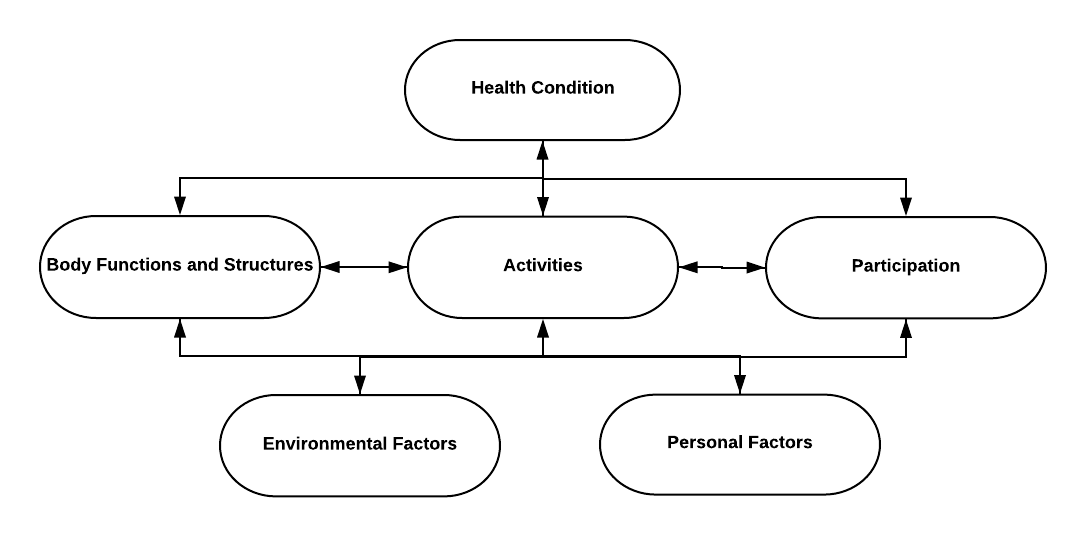Introduction to Basic Rehabilitation Techniques
Original Editors - Add your name/s here if you are the original editor/s of this page. User Name
Top Contributors - Naomi O'Reilly, Ewa Jaraczewska, Jess Bell, Tarina van der Stockt, Tony Lowe, Bruno Serra and Lucinda hampton
Introduction[edit | edit source]
Rehabilitation is a concept that is widely discussed globally. This is by no means unexpected since over a billion people live with a form of disability, accounting for over 15% of the world population. Furthermore, according to a recent report, 2.41 billion individuals worldwide live with the conditions that impact their functions in daily life and would benefit from rehabilitation services, which equates to 1 in 3 individuals requiring rehabilitation services throughout the course of their illness or injury. [1]
The term "rehabilitation" is used in many different contexts but the general underlying definition is based on the idea that each person has the right to be an active participant and expert in identifying their needs and making decisions on their health care. Currently there is no universal definition or understanding of rehabilitation, and it is portrayed in many ways depending on the context, including as a development issue, disability issue, health issue, human rights issue, substance abuse issue, and security issue, to name a few.
If we consider the definition of rehabilitation promoted by the World Health Organisation as "a set of measures that assist individuals who experience, or are likely to experience, disability to achieve and maintain optimal functioning in interaction with their environments”, then rehabilitation is a "set of interventions designed to optimise functioning in individuals with health conditions in interaction with their environment", and is in effect composed of multiple components or "interventions" to address issues related to all domains within the World Health Organisation's International Classification of Functioning, Disability and Health (ICF) including: body functions and structures, capacity for activities, the performance of activities, participation, environmental/contextual factors, and personal factors.[2].
International Classification of Functioning, Disability and Health (ICF)[edit | edit source]
The International Classification of Functioning, Disability and Health (ICF) is a biopsychosocial model of functioning, health and disability. Using standard language to define and measure disability, the ICF helps to explain how a person's body problems and social circumstances affect their functioning. Health conditions can refer to disease (acute or chronic), injury or trauma, which may also include other circumstances such as genetic predisposition, stress, pregnancy or ageing. Anyone with a health condition who experiences some form of limitation in functioning, such as cognition, emotion, vision, communication, motor and mobility, may need rehabilitation. As such rehabilitation is best characterised through use of the biopsychosocial model with use of interventions that address impairments in body functions and structures, activity limitations and participation restrictions, considering contextual factors both personal and environmental, that impact functioning.Most individuals participating in rehabilitation require interventions addressing one, many or all of the components of the ICF that are contributing to reduced functioning, with the overriding goal of rehabilitation being to utilise appropriate interventions that allow the individual to optimise their function.[2] Given this, individuals with health conditions or injuries may require rehabilitation at various points in time across the course of their lifespan. The timing and type of intervention that a rehabilitation provider selects depend greatly on several factors which include: the aetiology and severity of the person’s health condition; the prognosis; the way in which the person’s condition affects their ability to function in their environment; as well as the individual’s identified personal goals and what it is they want to achieve from the rehabilitation process.
The comprehensive and holistic nature of the ICF make it extremely useful in clinical practice.[3] The primary purpose of applying the ICF in clinical practice is to establish a common language for defining health and health-related states between providers.[4] It can enhance decision-making among health and social care professionals. The ICF's holistic approach is essential for making more informed assessments, developing more effective interventions, and achieving good patient outcomes.[3]
Clinical Assessment[edit | edit source]
Add your content to this page here!
Selection of Rehabilitation Techniques[edit | edit source]
Resources[edit | edit source]
References [edit | edit source]
- ↑ Duttine A, Battello J, Beaujolais A, Hailemariam M, Mac-Seing M, Mukangwije P, et al. Introduction to Rehabilitation Factsheet. Handicap International. 2016. Available from: https://humanity-inclusion.org.uk/sn_uploads/document/2017-02-factsheet-rehabilitation-introduction-web_1.pdf [Accessed on 8 January, 2020].
- ↑ 2.0 2.1 World Health Organization. World Report on Disability 2011. Geneva: World Health Organization, 2011. Rehabilitation.
- ↑ 3.0 3.1 Saleeby P. ICF and Application in Clinical Practice Course. Plus 2022
- ↑ Aims of the ICF. Available from https://www.icf-elearning.com/wp-content/uploads/ [last access 9.09.2022]







